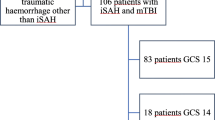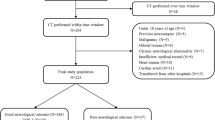Abstract
With advancing technology, the sensitivity of computed tomography (CT) for the detection of traumatic subarachnoid hemorrhage (tSAH) continues to improve. Increased resolution has allowed for the detection of hemorrhage that is limited to one or two images of the CT exam. At our institution, all patients with a SAH require intensive care unit (ICU) admission, regardless of size. It was our hypothesis that patients with small subarachnoid hemorrhage experience favorable outcomes, and may not require the intensive monitoring offered in the ICU. This retrospective study evaluated 62 patients between 2011 and 2014 who presented to our Level I trauma center emergency room for acute traumatic injuries, and found to have subarachnoid hemorrhages on CT examination. The grade of subarachnoid hemorrhage was determined using previously utilized scoring systems, such as the Fisher, Modified Fisher, and Claassen grading systems. Electronic medical records were used to evaluate for medical decline, neurological decline, neurosurgical intervention, and overall hospital course. Admitting co-morbidities were noted, as were the presence of patient intoxication and use of anticoagulants. Patient outcomes were based on discharge summaries upon which the neurological status of the patient was assessed. Each patient was given a score based on the Glasgow outcome scale. The clinical and imaging profile of 62 patients with traumatic SAH were studied. Of the 62 patients, 0 % underwent neurosurgical intervention, 6.5 % had calvarial fractures, 25.8 % had additional intracranial hemorrhages, 27.4 % of the patients had significant co-morbidities, and 1.6 % of the patients expired. Patients with low-grade tSAH spent less time in the ICU, demonstrated neurological and medical stability during hospitalization. None of the patients with low-grade SAH experienced seizure during their admission. In our study, patients with low-grade tSAH demonstrated favorable clinical outcomes. This suggests that patients may not require as aggressive monitoring as is currently provided for those with tSAH.
Similar content being viewed by others
References
Leon-Carrion J et al (2005) Epidemiology of traumatic brain injury and subarachnoid hemorrhage. Pituitary 8(3-4):197–202
Boers AM et al (2014) Automatic quantification of subarachnoid hemorrhage on noncontrast CT. AJNR Am J Neuroradiol 35(12):2279–2286
Lee J et al (2013) Head computed tomography utilization and intracranial hemorrhage rates. Emerg Radiol 20(3):219–223
Provenzale JM, Hacein-Bey L (2009) CT evaluation of subarachnoid hemorrhage: a practical review for the radiologist interpreting emergency room studies. Emerg Radiol 16(6):441–451
Maas AI et al (2007) Prognostic value of computerized tomography scan characteristics in traumatic brain injury: results from the IMPACT study. J Neurotrauma 24(2):303–314
Zhu GW, Wang F, Liu WG (2009) Classification and prediction of outcome in traumatic brain injury based on computed tomographic imaging. J Int Med Res 37(4):983–995
Balestreri M et al (2004) Predictive value of Glasgow Coma Scale after brain trauma: change in trend over the past ten years. J Neurol Neurosurg Psychiatry 75(1):161–162
Cortnum S, Sorensen P, Jorgensen J (2010) Determining the sensitivity of computed tomography scanning in early detection of subarachnoid hemorrhage. Neurosurgery 66(5):900–902, discussion 903
Sweeney TE et al (2015) Prediction of neurosurgical intervention after mild traumatic brain injury using the national trauma data bank. World J Emerg Surg 10:23
Washington CW, Grubb RL Jr (2012) Are routine repeat imaging and intensive care unit admission necessary in mild traumatic brain injury? J Neurosurg 116(3):549–557
Quigley MR et al (2013) The clinical significance of isolated traumatic subarachnoid hemorrhage. J Trauma Acute Care Surg 74(2):581–584
Wiedemayer H et al (2002) Early seizures following non-penetrating traumatic brain injury in adults: risk factors and clinical significance. Brain Inj 16(4):323–330
Annegers JF et al (1998) A population-based study of seizures after traumatic brain injuries. N Engl J Med 338(1):20–24
Frontera JA et al (2006) Prediction of symptomatic vasospasm after subarachnoid hemorrhage: the modified fisher scale. Neurosurgery 59(1):21–27, discussion 21-7
Muizelaar JP et al (1999) The prophylactic use of transluminal balloon angioplasty in patients with Fisher Grade 3 subarachnoid hemorrhage: a pilot study. J Neurosurg 91(1):51–58
Klein Y et al (2010) Management of patients with traumatic intracranial injury in hospitals without neurosurgical service. J Trauma 69(3):544–548
Overton TL et al (2014) Can trauma surgeons manage mild traumatic brain injuries? Am J Surg 208(5):806–810
Borczuk P et al (2013) Patients with traumatic subarachnoid hemorrhage are at low risk for deterioration or neurosurgical intervention. J Trauma Acute Care Surg 74(6):1504–1509
van Essen TA, Heeringa JJ, Muizelaar JP (2010) (In)appropriate neurosurgical consultation. Clin Neurol Neurosurg 112(9):775–780
Huynh T et al (2006) Utility of neurosurgical consultation for mild traumatic brain injury. Am Surg 72(12):1162–1165, discussion1166-7
Gerberding JL, B., S (2003) National center for injury prevention and control: report to congress on mild traumatic brain injury in the United States: steps to prevent a serious public health problem centers for disease control and prevention, National Center for Injury Prevention and Control
Greene KA et al (1995) Impact of traumatic subarachnoid hemorrhage on outcome in nonpenetrating head injury. Part I: a proposed computerized tomography grading scale. J Neurosurg 83(3):445–452
Author information
Authors and Affiliations
Corresponding author
Ethics declarations
Conflict of interest
We wish to confirm that this article is not under consideration for publication elsewhere. Each author has participated sufficiently in the composition and revision of this article. The authors of this article have approved of the final version being submitted. None of the authors have any conflicts of interest, financial or personal, that would inappropriately influence the actions of this work.
Rights and permissions
About this article
Cite this article
Albertine, P., Borofsky, S., Brown, D. et al. The clinical significance of small subarachnoid hemorrhages. Emerg Radiol 23, 207–211 (2016). https://doi.org/10.1007/s10140-016-1377-2
Received:
Accepted:
Published:
Issue Date:
DOI: https://doi.org/10.1007/s10140-016-1377-2




